
Spectres Taking Shape
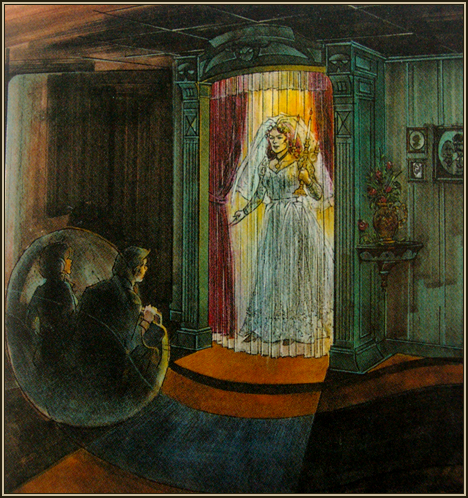 Concept art of the Bride’s Welcome by Fernando Tenedora. © Disney. Concept art of the Bride’s Welcome by Fernando Tenedora. © Disney.
The characters that would visually accompany guests through the ride, it was decided, were to be the ghostly abandoned bride, a character appearing only briefly in the original attraction, and our “ghost host” himself – here taking the shape of an evil obscure presence known only as “the Phantom”.
The story, as it would play out during the ride, went that the Phantom killed the bridegroom by hanging him in the attic, leaving the bride to haunt the house for all eternity...
In order to further adapt the attraction to European sensibilities, the Imagineers looked at a number of classic European works for inspiration. The Phantom of the Opera by Gaston Leroux and its famous musical adaption, for instance, were instrumental in determining the tone and feel of the ride. The character of Miss Haversham from Charles Dickens’ Great Expectations was the inspiration for the image of an abandoned bride passing decades in her tattered wedding dress, waiting for her groom to return until old age.
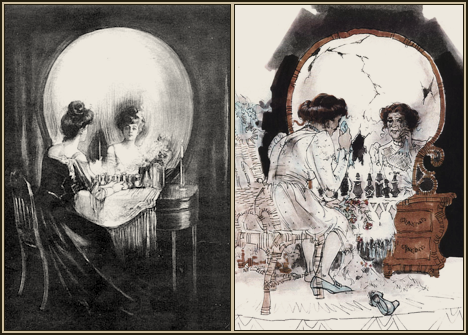 An old Victorian illustration by Charles Allen Gilbert titled “All is Vanity” was the visual inspiration for the Bride’s Boudoir scene. Concept art (right) by Fernando Tenedora © Disney. An old Victorian illustration by Charles Allen Gilbert titled “All is Vanity” was the visual inspiration for the Bride’s Boudoir scene. Concept art (right) by Fernando Tenedora © Disney.
Visual artists such as Fernando Tenedora, Julie Svendsen and Christian Hope were fleshing out the numerous new characters and show scenes. Julie Svendsen herself remembers that Tenedora’s illustrations in particular “were so comprehensive and correct that they were reproduced in the mansion down to the gels on the show lighting.”
The imagineers realized that the ride’s grand finale through a large gothic graveyard would neither be fitting for the Western setting, nor, they argued, would it much impress European audiences who were used to their own brand of magnificent gothic architecture. In keeping with the ride’s location in Frontierland, the graveyard was replaced by the nightmarish image of an Old West ghost town with coyotes baying in the sunset and joyful spirits meeting in the earthquake-ridden saloon.
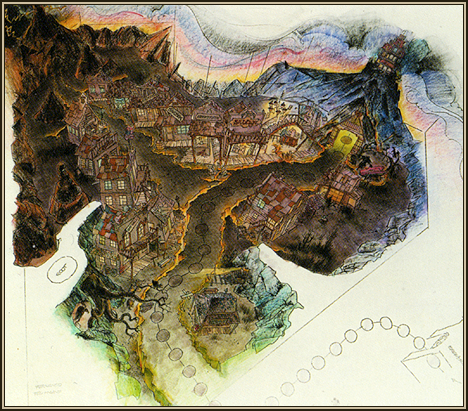 Phantom Canyon overview by Fernando Tenedora. © Disney. Phantom Canyon overview by Fernando Tenedora. © Disney.
Taking into account the often inclement weather of central Europe, a large part of the queue area would be covered. Imagineers initially developed the concept of a grand carriage-house that would protect those waiting in line from rain, snow or grail. This lavishly themed two-story structure made it all the way into the early model stage...
When the budget was tightened, however, the carriage-house made way for a simpler garden pavillion in order to avoid sacrifying more important elements from the ride itself. Fernando Tenedora created a seperate piece of concept art (below), showing how the garden pavillion would have been used for social get-togethers by the upper class of Thunder Mesa, in order to convey this new idea.
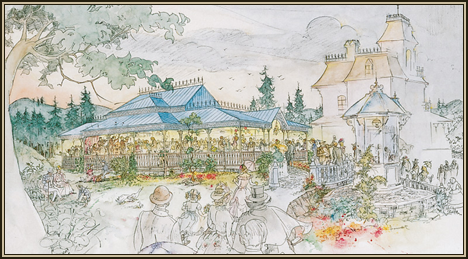
Once the final look of the manor-house and its surroundings had been determined, Julie Svendsen created a painting depicting the mansion in all its beauty, in pristine condition with fresh white paint and a red gable roof for the ride’s Grand Hall scene. She also contributed a number of acrylics paintings of the bride herself as well as new stretching portraits for the Doorless Chamber, redesigned to reflect the story’s new characters and setting.
As three-dimensional models were being built, show designer Christian Hope and his friend, musician Marco Monahan created a first temporary soundtrack for the attraction, taking the classic “Grim Grinning Ghosts” tune of the Haunted Mansion in Waltz time and giving it a cinematic make-over that would convey the eerie mood and dramatic story of the new ride concept. The attraction’s audio producer, Greg Meader, mixed this haunting demo with sound effects from the Haunted Mansion and a variety of other sources for early demonstrations involving scale maquettes in the model shop.
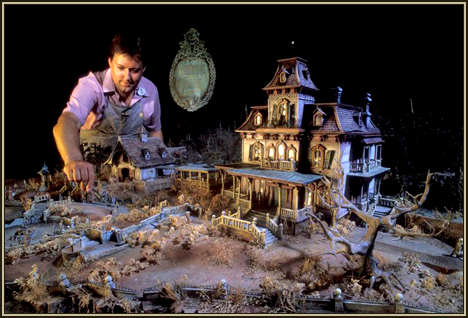 Imagineer Bob Baranick with a maquette of the Manor exterior. © Disney. Imagineer Bob Baranick with a maquette of the Manor exterior. © Disney.
To represent the character of the Phantom, the imagineers took the spooky laughter recorded by horror movie legend Vincent Price for Michael Jackson’s 1982 hit Thriller and mixed it into this first mock-up soundtrack. “Once everyone heard this it became impossible to imagine Phantom Manor without Vincent Price’s laugh,” remembers Greg Meader. Since it was such a perfect fit, the actor was approached, and “fortunately for us Vincent agreed to do the ride narration.”

|

